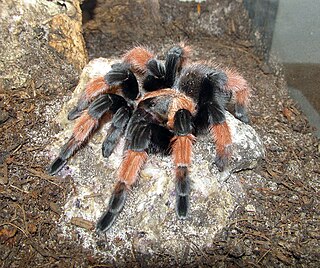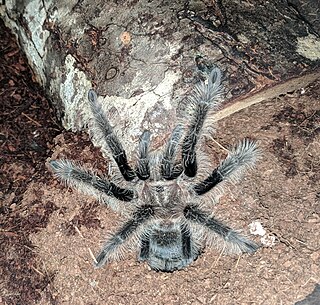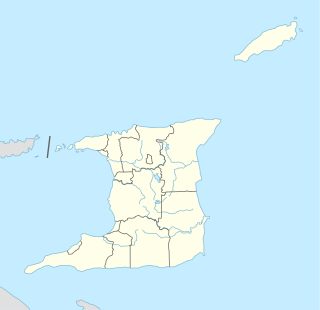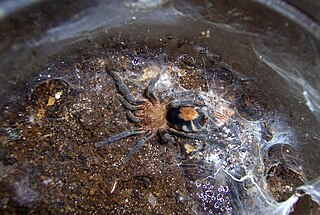
The Goliath birdeater belongs to the tarantula family Theraphosidae. Found in northern South America, it is the largest spider in the world by mass – 175 g (6.2 oz) – and body length – up to 13 cm (5.1 in) – but it is second to the giant huntsman spider by leg span. It is also called the Goliath bird-eating spider; the practice of calling theraphosids "bird-eating" derives from an early 18th-century copper engraving by Maria Sibylla Merian that shows one eating a hummingbird. Despite the spider's name, it rarely preys on birds.

Brachypelma is a genus of spiders in the family Theraphosidae (tarantulas). They may have bodies up to 6 cm long with legs of similar or greater lengths. Some species have brightly colored legs, with red or orange marks and rings.

Chromatopelma is a monotypic genus of South American tarantulas containing the single species, Chromatopelma cyaneopubescens. Commonly known as greenbottle blue tarantulas due to their metallic blue legs and blue-green carapace, they are very active and fast-growing tarantulas that are particularly attractive to hobbyists. They are native to the Paraguaná Peninsula.

Aphonopelma seemanni, the Costa Rican zebra tarantula, also known as the striped-knee tarantula, is a species of tarantula inhabiting most of western Costa Rica and other parts of Central America, such as Honduras and Nicaragua, and possibly Guatemala. It is usually black with white stripes near the leg joints, but a brown color form also exists for the spider.
The genus Selenotypus includes one of the largest of Australia's theraphosids. At present, the only recognised species within this genus is Selenotypus plumipes, but this is expected to change, as it is becoming apparent that the genus has a wide distribution, and at present Australian theraphosids as a whole are poorly classified.

Aphonopelma chalcodes, commonly known as the western desert tarantula, Arizona blond tarantula or Mexican blond tarantula is a species of spider belonging to the family Theraphosidae. It has a limited distribution in the deserts of Arizona and adjacent parts of Mexico but can be very common within this range. The common name "blond tarantula" refers to the carapace, which is densely covered in pale hairs, and contrasts strongly with the all-dark legs and abdomen. Additionally, these spiders have low toxicity, a long life expectancy, and several offspring.

Tliltocatl albopilosus is a species of tarantula, also known as the curlyhair tarantula.

Tarantulas comprise a group of large and often hairy spiders of the family Theraphosidae. Currently, 1,010 species have been identified. The term "tarantula" is usually used to describe members of the family Theraphosidae, although many other members of the same infraorder (Mygalomorphae) are commonly referred to as "tarantulas" or "false tarantulas". Some of the more common species have become popular in the exotic pet trade. Many New World species kept as pets have setae known as urticating hairs that can cause irritation to the skin, and in extreme cases, cause damage to the eyes.

Cedar Hill Village is a rural community in Trinidad and Tobago which covers an area of approximately four square kilometres. It is about two kilometres from Princes Town. It can be found along the Manahambre Road.

Psalmopoeus cambridgei, the Trinidad chevron tarantula, is a species of spider in the family Theraphosidae, endemic to Trinidad. Its venom is the source of psalmotoxin and vanillotoxin which are classified as inhibitor cystine knot proteins. Psalmotoxin may be of therapeutic use in patients suffering from a stroke.

The skeleton tarantula, Ephebopus murinus, is a species of spider belonging to the family Theraphosidae (tarantulas), sub-family Aviculariinae. A New World species, it is native to several South American countries. Its common name is derived from the skeleton-like markings on its legs.

Cyriocosmus is a genus of tarantulas that was first described by Eugène Louis Simon in 1903.

Aphonopelma anax, commonly known as the Texas tan tarantula, is a species of spider belonging to the family Theraphosidae native to southern Texas and northern Mexico.

Tapinauchenius is a genus of tarantulas that was first described by Anton Ausserer in 1871. The name is a combination of the Greek ταπεινός, meaning "low", and αὐχήν, meaning "neck". Several species, including T. gigas, have been moved to Pseudoclamoris.

The Malaysian earthtiger tarantula, scientific name Omothymus schioedtei, is a species of spider in the family Theraphosidae (tarantulas), found in Peninsular Malaysia. It is also known by the synonym Cyriopagopus schioedtei.

Neoholothele incei is a species of tarantula from Trinidad and Venezuela, commonly called the Trinidad olive tarantula. When mature, the species has a leg-span exceeding 5–7.5 cm (2.0–3.0 in). As often the case with tarantulas, the females live longer than males, with the former living up to 7 years compared to the 2 years that males can expect to reach. N. incei is a bird spider and is fossorial. It is commonly kept as a pet as it is easy to breed. Rarely for tarantulas, N. incei is known to live communally and cannibalism is rare except for times of extreme hunger. Like most New World species, the venom of N. incei is considered to be mild and comparable to a bee sting, however no research has confirmed this.

Holothele is a genus of tarantulas that was first described by Ferdinand Anton Franz Karsch in 1879. Originally placed with the curtain-web spiders, it was transferred to the tarantulas in 1980.

Tliltocatl schroederi is a species of spiders in the family Theraphosidae (tarantulas), found in Mexico. It is found in the central valley in Oaxaca State, Mexico.

The Trinidad mangroves ecoregion covers the separate mangrove forest areas on the coast of the island of Trinidad, in the country of Trinidad and Tobago. The character of the mangroves is affected by the large amount of fresh water flowing out of the Orinoco River and Amazon River to the south, which flow northwest around the island. The mangroves of Trinidad are found on all coasts, and are usually in the estuaries of rivers, but also found in coastal lagoons.

The Trinidad and Tobago moist forests ecoregion covers most of Trinidad Island and Tobago Island near the coast of South America where the southeastern Caribbean Sea meets the Atlantic Ocean. Small portions of the islands around river estuaries and coastal lowlands are mangroves or dry forests. Species diversity is very high, in particular for plants and birds. Tobago, being much smaller, has fewer species.



















